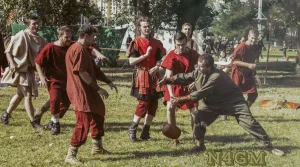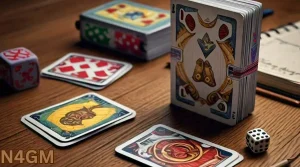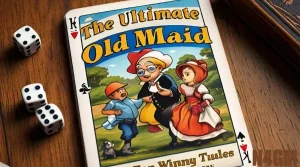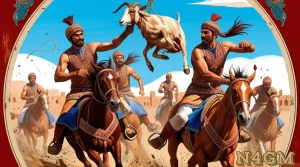Knattleikr (The Viking Ball Game) was a game that Vikings in Iceland enjoyed from the 9th to the 14th centuries. Players used bats to hit a hard ball while also wrestling and tackling their opponents.
Despite being an important part of Viking history, This game is not well known today. This article aims to share more about this intriguing Viking pastime and look at the current efforts to bring the game back to life.
Origins & Historical References
The term “knattleikr” means “ball game” in Old Norse. The game is mentioned in various Icelandic sagas, including the Grettis, Gísla, Egils, and Eyrbyggja Saga.
According to the sagas, both children and adults played this, which may last from morning to night. Tournaments were big events that drew large crowds from all over Iceland, emphasizing the game’s importance in Viking culture.
Rules, Equipment, & Gameplay
1. The Exact Rules
- Unclear Rules: The exact rules of this Viking Ball Game were never formally codified in medieval times. Researchers have reconstructed a general understanding from saga references.
- Team Division: Typically, two teams of two or more players each.
- Ball and Bat: A hard ball, possibly made of wood or leather, was hit by a bat. Players without the ball could catch and throw it back.
- Physical Contact: Tackling and holding were integral parts of the game, with the strongest players likely having the best chance of winning possession.
- Penalties: There were penalties and a penalty box, but specific details remain unclear.
2. The Playing Field
- Surface: Likely a flat surface, either ice or grass.
- Markings: In some cases, the field was lined.
- Traction: Players may have used tar and sand under their boots for better traction on icy surfaces.
3. Equipment
- Basic Gear: The game required a ball (knatt) and a bat or stick (knattleikr stick).
- Ball: Usually made of wood or animal hide filled with hair.
- Stick: Used to hit the ball.
4. Gameplay
- Teams: Two teams competed against each other.
- Objective: Hit the ball and keep it away from the other team.
- Playing Methods: Players could use their sticks or hands to hit and throw the ball.
- Physical Play: The game involved rough play, with players tackling each other.
- Scoring: Played until one team scored a set number of points.
Cultural Significance
1. Vikings & Sports
Sports held a significant place in Viking culture, with knattleikr being more than just a game. It was a way for Vikings to demonstrate their physical strength and bravery, and it served as practice for battle. Beyond its role in training, it also helped to unite communities, often being played during festivals and gatherings.
2. Mentions In The Sagas
This is referenced in several Icelandic sagas, which are stories about Viking heroes and their adventures. One notable saga, “Grettir’s Saga,” features the hero Grettir playing. These sagas highlight how it was a respected and cherished game among the Vikings.
Comparison To Modern Sports
1. Similarities To Other Sports
It has similarities to many modern sports:
- It is similar to baseball because of the bat and ball.
- It has elements of rugby with its rough physical play.
- It also shares some aspects with hockey, especially when played on ice.
2. Differences From Modern Sports
While there are similarities, there are also differences:
- It had no fixed rules, unlike modern sports.
- The playing field could vary in size and location.
- It was much rougher and less organized than today’s sports.
Revival
In recent years, there have been efforts to reconstruct and revive the game of Vikings ball. The New England Viking reenactment group Hurstwic has been at the forefront of these efforts, experimenting with different rules and equipment.
Hurstwic’s version of this game is played annually at their feast in Massachusetts. Players use hardwood dowels as bats and either soft foam balls or hurling balls, depending on the intensity of the match. Protective padding is worn to mitigate the risks of the physical game.
Other groups, such as the Minjasafn Austurlands in Iceland, have also organized knattleikr matches. The game has also been depicted in the 2022 film “The Northman”.
Challenges And Risks
Reconstructing it comes with its fair share of challenges and risks. The limited historical information makes it difficult to determine the exact rules and gameplay. There is also the risk of injury due to the physical nature of the game.
The New England Viking reenactment group Hurstwic cautions that it can be dangerous and refers to the Icelandic Grágás laws, which state that a player may leave the game at any time.
While no serious injuries have occurred during Hurstwic’s matches, there have been some close calls, such as when a ball flew out of bounds and hit a spectator in the head.
FAQs
This is an ancient Viking ball game played with a ball and a stick. It was popular in Iceland during the Viking Age.
Q.2 Why did the Vikings play this game?
Vikings played it for fun, fitness, and to show their strength and bravery. It was also a way to prepare for battle and bring communities together.
Q.3 Is this still played today?
Yes, some groups and societies play Knattleikr today. They recreate the game based on historical descriptions and play it at Viking festivals and reenactments.
Conclusion
Knattleikr, the forgotten Viking ball game, provides a captivating look into medieval Iceland’s culture and pastimes. Despite scarce historical details, dedicated researchers and enthusiasts have worked to reconstruct and revive the sport.
Challenges in accurately determining the rules persist, but efforts to resurrect them are commendable. Sharing this aspect of Viking culture with today’s audiences enhances our appreciation for the Vikings’ rich history and traditions.
As interest in it grows, its evolution and adaptation to modern times will be exciting to watch. Whether played at Viking reenactments, college campuses, or featured in popular media, it stands as a testament to the enduring spirit and creativity of the Vikings.







